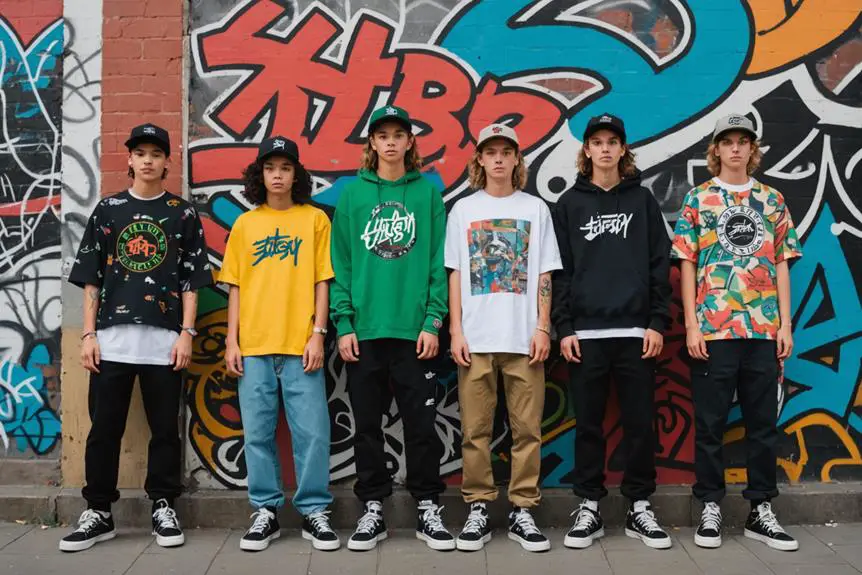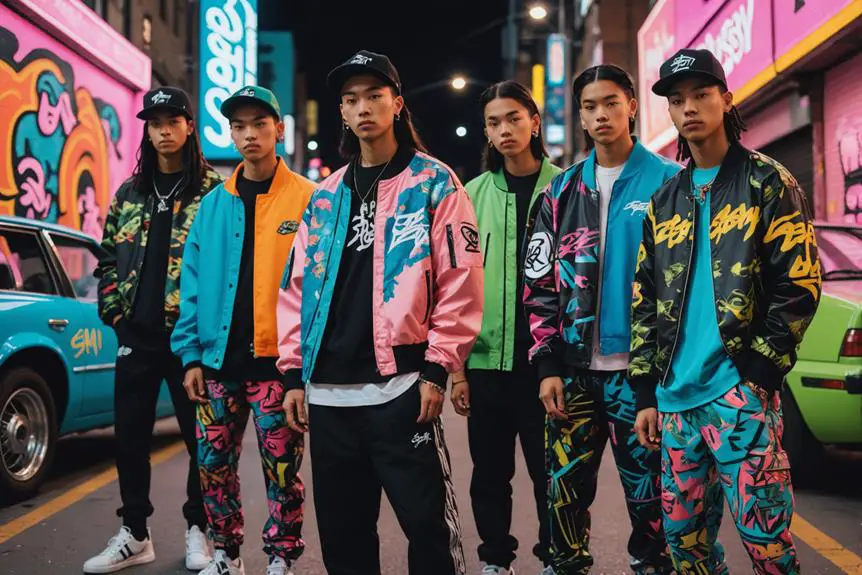Stussy began in 1979 when Shawn Stussy, deeply rooted in Laguna Beach's surf culture, handprinted surfboards with bold graphics. By 1984, the brand evolved into a clothing line that captured the attention of streetwear enthusiasts. Stussy's rise was propelled by strategic collaborations and grassroots marketing, crafting an iconic identity that resonated with diverse subcultures. The establishment of the International Stussy Tribe fostered a global community, while innovative partnerships ensured continued relevance in the ever-changing landscape of fashion. As the brand navigated leadership transitions and embraced sustainability initiatives, it solidified its status as a cornerstone of streetwear. Explore the stages of its evolution and what exciting developments lie ahead for Stussy.
Origins and Initial Focus

When you explore the origins of Stussy, you'll find that it began as a passionate venture by Shawn Stussy in 1979, rooted in the vibrant surf culture of Laguna Beach, California. Initially, the brand focused on hand-printed surfboards, which were not just functional but also a canvas for bold graphics and graffiti-style logos. These designs, marked by Stussy's unique touch with a black marker, resonated deeply with surfers and skaters in the area, laying the groundwork for what Stussy would eventually become.
The brand's history took a significant turn in 1982, when a successful trade show led to the sale of nearly 1,000 t-shirts. This moment marked a pivotal change, indicating a growing demand for Stussy's style beyond just surfboards. As Stussy became more than a surfboard brand, it began to cultivate a lifestyle that embraced California's laid-back ethos. This early focus on surf culture not only defined its identity but also created a loyal following. By the time it evolved into a clothing brand in 1984, Stussy had firmly established itself as an influential player in the burgeoning streetwear scene, retaining its roots while expanding its reach.
Transition to Clothing Brand
As Stussy built its reputation in the surf community, the brand recognized a shift in consumer interests and expanded its vision. The turning point came after a successful trade show in 1982, where nearly 1,000 t-shirts flew off the shelves compared to just 24 surfboards. This marked the beginning of Stussy's changeover to a clothing brand, fully realized in 1984 when it officially relaunched.
During this period, Stussy strategically embraced various subcultures, collaborating with artists and musicians, which broadened its appeal beyond just surfers. The opening of a store in New York in 1991 played a significant role in tapping into the burgeoning streetwear movement, increasing visibility among youth.
Key aspects of this changeover include:
- A diverse range of lifestyle apparel reflecting changing trends
- Expansion into international markets, solidifying its streetwear brand status
- Focus on community engagement through collaborations, emphasizing cultural relevance
Growth and Cultural Movement

Stussy's growth during the late 1980s and early 1990s exemplifies the brand's transformation into a cultural phenomenon that transcended mere fashion. By 1990, Stussy was generating $17 million in annual revenue, reflecting its rapid ascent within youth subcultures. The emergence of the International Stussy Tribe (IST) during this period fostered a vibrant cultural movement, connecting enthusiasts of music, fashion, and design. This community not only solidified Stussy's relevance but also created a sense of belonging among its members. Much like the evolution of other iconic brands such as Betty Barclay, Stussy embraced the unique aesthetics of its time, appealing to a diverse audience.
Stussy's brand campaigns in cult publications like The Face and Thrasher enhanced its organic popularity and credibility within the streetwear scene. Custom varsity jackets became emblematic of IST membership, further establishing Stussy's cultural significance as a symbol of identity and style. Influential figures such as Luca Benini and Hiroshi Fujiwara played essential roles in shaping the brand's perception, helping it penetrate the fashion industry more deeply.
Through these efforts, Stussy transcended traditional fashion boundaries, becoming a touchstone for a broader cultural movement that resonated with youth worldwide. You can see how this growth not only impacted sales but also redefined the relationship between fashion and culture.
Marketing Strategies and Collaborations
The evolution of Stussy's cultural significance naturally led to innovative marketing strategies and impactful collaborations that would further solidify its place in the streetwear landscape. Central to its approach is grassroots marketing, emphasizing authenticity and community engagement. By fostering a loyal customer base through limited product availability, Stussy creates exclusivity and desirability around its brand.
Key strategies include:
- In-house Marketing: Stussy conducts its marketing shoots independently, ensuring control over its image and messaging.
- Pioneering Collaborations: The brand's first collaboration with G-SHOCK in 1997 marked its entry into impactful partnerships, which helped revive forgotten sneaker silhouettes.
- Strategic Partnerships: Collaborations with renowned names like Nike and recent ventures with Cactus Plant Flea Market and Porter-Yoshida have broadened Stussy's influence across streetwear and high fashion.
These initiatives not only enhance Stussy's visibility but also reinforce its identity as a brand that values community and creativity. By consistently aligning with cultural movements, Stussy demonstrates a keen understanding of its audience, ensuring its relevance in an ever-evolving fashion landscape.
Cultural Impact and Brand Identity

Emerging from the vibrant subcultures of the 1980s and 1990s, Stussy's impact on both culture and fashion cannot be overstated. The brand's logo, a simple yet iconic design, became a cultural symbol for surfers, skaters, and musicians, setting it apart from competitors who favored bold graphics. This understated aesthetic helped cultivate a distinct brand identity that resonated deeply with its audience.
Stussy's authenticity fostered a timeless appeal, seamlessly blending surf culture with contemporary fashion trends. By doing so, it played a pivotal role in shaping streetwear fashion during the 1990s, influencing countless brands and designers to adopt a similar ethos. This unique approach not only elevated Stussy's status but also contributed to the broader cultural impact of skate and surf culture globally.
Additionally, Stussy nurtured a sense of community through the International Stussy Tribe, connecting designers, musicians, and artists under a shared identity. Today, the brand remains synonymous with the California lifestyle, reflecting its deep roots in cultural movements. Stussy's contributions continue to be recognized and celebrated, underscoring its lasting significance in both fashion and youth culture.
Leadership Transition and Evolution
With a strong cultural foundation, Stussy faced significant changes in leadership that shaped its future direction. After Sean Stussy sold his stake in 1996, many worried about the brand's trajectory. However, Frank Sinatra Jr. stepped in as the sole owner and CEO of the brand, successfully steering through the post-Sean era. He recognized the need for collaboration as a crucial marketing strategy and launched successful partnerships, like the one with G-Shock in 1997, which fortified Stussy's foothold in street fashion.
Later, David Sinatra took the helm, initiating a shift towards higher-end clothing. Under his leadership, Stussy celebrated its 40th anniversary with collaborations featuring prominent fashion figures, showcasing the brand's adaptability and commitment to innovation.
Key elements of Stussy's leadership change include:
- Maintaining a cult following, especially in Japan
- Strategic collaborations that defined its marketing approach
- A focus on sustainability and ethical production practices
Today, as Stussy continues to evolve, it remains dedicated to its core identity while adapting to changing consumer trends, ensuring its legacy in the fashion world endures.
Notable Collaborations Over Time

Stussy's evolution in the fashion landscape is markedly defined by its notable collaborations, which have allowed the brand to blend various cultural influences while appealing to diverse audiences. Each partnership not only expands Stussy's creative reach but also solidifies its position within different cultural contexts.
| Year | Collaboration | Key Features |
|---|---|---|
| 2011 | Marvel | T-shirts featuring popular superhero designs, merging streetwear with comic book culture. |
| 2019 | Matthew Williams | Collection of recycled organic cotton tees and leather hiking boots, emphasizing sustainability. |
| 2020 | Matthew Williams | Expansion into denim products, furthering sustainable fashion initiatives. |
| 2020 | Comme des Garçons | Celebrated Stussy's 40th anniversary, blending high fashion with streetwear roots. |
| 1997 | G-SHOCK | Revitalized interest in watch culture through unique designs. |
| 2001 | Nike Dunk | Elevated sneaker culture with innovative styles. |
These collaborations highlight Stussy's adaptability and its commitment to innovation within the fashion industry. Each project not only enhances the brand's aesthetic but also reflects its ongoing dialogue with contemporary culture, hence ensuring its relevance across generations.
Current Status in Fashion
As of 2023, Stussy stands at the forefront of the streetwear industry, firmly establishing itself as a leader by emphasizing sustainability and ethical production practices. This commitment not only resonates with eco-conscious consumers but also sets a benchmark within the American market. You'll notice how Stussy has evolved, expanding its offerings beyond surfwear to embrace lifestyle apparel, reflecting the shifting trends and preferences of today's shoppers.
To remain relevant, Stussy actively engages with digital platforms and social media, targeting younger audiences through innovative collaborations. This strategy has proven effective in cultivating a loyal customer base while staying true to its roots.
Key aspects of Stussy's current status include:
- Sustainable practices: Prioritizing eco-friendly materials and ethical production.
- Dynamic collaborations: Partnering with influential fashion figures and brands, like the CDG collaboration for its 40th anniversary.
- Balancing exclusivity and accessibility: Ensuring that the brand remains both desirable and attainable, solidifying its reputation in the global streetwear market.
Future Directions and Trends

Amidst the ever-evolving landscape of streetwear, a significant trend is emerging: brands like Stussy are increasingly prioritizing sustainable innovation as a core element of their future strategies. As of 2023, Stussy's commitment to sustainability and ethical production practices appeals to environmentally conscious consumers, aligning the brand with contemporary values.
You'll notice Stussy leveraging digital platforms and social media to engage younger audiences, enhancing its marketing strategies and broadening its reach. This approach not only keeps the brand relevant but also guarantees that it resonates with the values of its target demographic.
Stussy continues to walk the fine line between exclusivity and accessibility, maintaining its cult status while appealing to a wider market. Ongoing collaborations with prominent fashion figures and brands further reflect Stussy's dedication to innovation, allowing it to infuse fresh perspectives while preserving its core identity.
In a rapidly changing fashion landscape, Stussy's adaptability to trends guarantees it remains a key player in streetwear culture, embodying a future where sustainability and creativity coexist harmoniously. By embracing these future directions, Stussy positions itself as a leader in the evolving streetwear narrative.
Frequently Asked Questions
What Is the Brief History of Stussy?
Stussy's journey showcases its evolution from hand-printed surfboards to a leading streetwear brand. By capitalizing on cultural movements, it embraced collaborations and innovative designs, ensuring its relevance and influence in contemporary fashion.
What Does Stussy Stand For?
Stussy stands for a unique blend of surf culture and urban streetwear, reflecting individual expression, creativity, and community. It's not just a brand; it's a lifestyle that resonates with diverse subcultures globally.
What's so Special About Stussy?
You'll find Stussy's uniqueness lies in its blend of surf culture and urban style. Its innovative designs, iconic logo, and strong community ties make it a standout brand, influencing streetwear and fashion trends worldwide.
Is Stussy Considered Luxury?
You might consider Stussy a luxury brand due to its collaborations with high-fashion designers and exclusive products. Its blend of streetwear with luxury aesthetics elevates its status, appealing to both collectors and fashion enthusiasts alike.





Thank you for your sharing. I am worried that I lack creative ideas. It is your article that makes me full of hope. Thank you. But, I have a question, can you help me?
I have recommended this blog to all of my friends and family It’s rare to find such quality content these days!
This is a great read. Thanks for sharing your insights! And also please SignUp and get 30USD FREE investment plan at https://investurns.com/
I don’t think the title of your article matches the content lol. Just kidding, mainly because I had some doubts after reading the article.
I don’t think the title of your article matches the content lol. Just kidding, mainly because I had some doubts after reading the article.